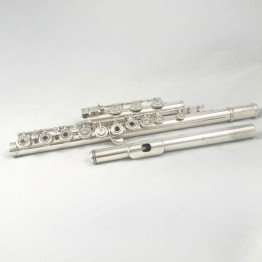
Powell's history is very much tied to their namesake, Verne Q. Powell. A jeweler by trade, Powell fashioned himself a flute in 1910 from whatever silver he could get his hands on, including silver dollars, watch casings, and spoons. This incredible feat of metal working landed him a job at a flute company in Boston. He worked there until 1926, leaving to create his own company. His goal was to be able to produce the world’s finest French flutes, and creating his own company gave him the freedom to devote himself to detail and artistry.
His instruments were immediately recognized as the very best a flutist could play, and endorsements flowed in from flutists around the globe. In 1928 he completed his first all 14K Gold flute; soon, piccolos and alto flutes were added. By 1930 the brand had representation in the Boston, Detroit, Philadelphia, Cleveland, Baltimore, and New York Orchestras. There were flutes which had a life of their own: William Kincaid's #365, known as the 'World’s Fair' Platinum flute; #900, the only flute ever made entirely of 14K White Gold; and #1142, the “Signature” Flute.
Over the decades innovation has became a hallmark of the Powell company, as they were the first to commercially use the Cooper Scale, the first company to mix silver and gold with the Aurumite flute, and the first to make 19.5K Rose Gold flutes.
The 2100 and 3100 series flutes were developed in the early 90’s, ultimately leading to the debut of today’s Conservatory flutes. The first Conservatory flute was unveiled in 2002 to celebrate the company’s 75th anniversary, alongside another new instrument, the Powell Sonaré flute. A year later the Signature flute was launched. 2005 and 2006 saw brand new headjoint styles: the Soloist and the Venti. In 2007 Powell patented a new method for extruding tone holes which is now widely used today. NASA Astronaut Cady Coleman brought her Powell flute on the International Space Station in 2011, making it the only handmade flute to be played in space.



















